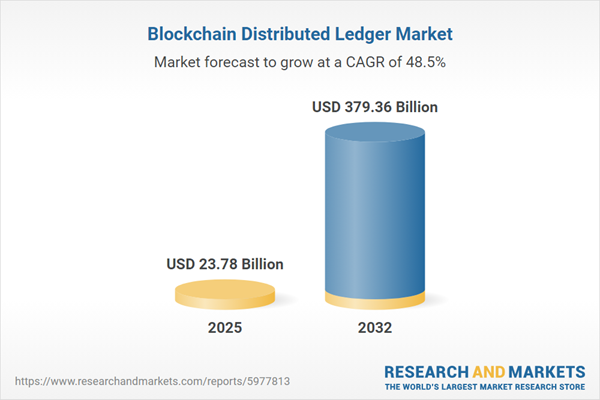Speak directly to the analyst to clarify any post sales queries you may have.
Enterprises are embracing blockchain distributed ledger technology to establish secure, compliant digital operations and strengthen data exchange. Technology leaders prioritize blockchain to drive resilient infrastructure, streamline oversight, and address emerging industry regulations.
Market Snapshot: Blockchain Distributed Ledger Technology
The blockchain distributed ledger market is experiencing sustained and rapid expansion, with the total addressable market projected for sharp growth between 2024 and 2032. Demand from enterprises is increasing as organizations require robust and secure digital infrastructure for trusted data sharing and enhanced compliance. Sectors such as financial services, public institutions, and technology-driven enterprises are actively investing to boost data reliability and cybersecurity. Senior leaders oversee the deployment of distributed ledger platforms to increase transparency, drive workflow efficiency, and support digital transformation initiatives. These advancements enable organizations to adapt to shifting regulatory expectations and maintain competitive positioning in dynamic sectors.
Scope & Segmentation of Blockchain Distributed Ledger Technology
- Component: Secure hardware delivers scalable ledger support across complex systems. Consulting and managed services assist organizations in optimizing deployments and navigating compliance hurdles. Flexible software solutions integrate seamlessly with both regulatory requirements and legacy environments for greater agility.
- Application: Distributed ledger technology accelerates payment processing, overhauls trade finance operations, and modernizes public sector service delivery. It enhances healthcare data management, advances supply chain transparency, and supports secure digital identity for reliable transactions across enterprise and regulated industries.
- Type: Private blockchains prioritize confidentiality to meet stringent enterprise demands. Public blockchains enable open collaboration and transparent engagement. Hybrid solutions offer a blend of privacy and openness, allowing tailored access and control over sensitive information.
- Deployment: Cloud-based deployment meets demand for scalability and risk mitigation, while on-premise and hybrid implementations provide organizations with choices for compliance, customization, and data sovereignty.
- Organization Size: Blockchain distributed ledger technologies are designed to support both large and small-to-medium-sized organizations. Their scalable architecture and integration capacity facilitate adoption by enterprises with differing legacy systems and budget constraints.
- Regions: The Americas demonstrate leadership in adoption and regulatory compliance, while Europe coordinates unified regulation and sector-wide deployment. Asia-Pacific is intensifying digital infrastructure investment, and the Middle East and Africa pursue targeted implementations to address local compliance requirements and policy frameworks.
- Key Companies: Major players, including IBM Corporation, Microsoft Corporation, Amazon Web Services, SAP SE, Oracle Corporation, Huawei, Alibaba Cloud, Cisco Systems, Accenture, and Fujitsu, provide governance-driven platforms with a focus on cross-border interoperability and compliance for business-critical needs.
Key Takeaways for Senior Decision-Makers
- Distributed ledger technology improves operational transparency, generating comprehensive audit trails essential for complex enterprises.
- Blockchain-as-a-service solutions simplify adoption and integration, making it efficient to unify processes across diverse networks and business units.
- The use of smart contracts and tokenization enhances process automation, boosting asset management efficiency and streamlining compliance activities.
- Consortium blockchains support unified response to shifting regulatory policies, improving industry-wide alignment and compliance management.
- Adaptable deployment models help organizations stay agile, aligning quickly with evolving local conditions and discovering fresh opportunities in new markets.
- Investment in scalable ledger infrastructure signals a strong commitment to proactive risk management, operational refinement, and future-ready capabilities.
Tariff Impact
The upcoming US tariff regulations for 2025 are set to shift cost dynamics across the blockchain distributed ledger market. Enterprises must manage rising hardware and infrastructure expenses, leading to increased interest in domestic suppliers and a shift toward software virtualization strategies. Procurement professionals are reevaluating contract terms, expanding remote management, and optimizing budgets to align operational efficiency with compliance obligations as market conditions evolve.
Methodology & Data Sources
This report’s findings derive from executive interviews, expert market analysis, and inputs from regulatory bodies. Complementary sector studies, technical white papers, and patent analyses offer cross-validated perspectives on distributed ledger adoption and industry trends.
Why This Report Matters
- Empowers executive teams to craft blockchain strategies and supports confident integration of distributed ledger systems across departments.
- Clarifies adoption and deployment trends by sector and region, informing decisions around partnerships, planning, and active ecosystem involvement.
- Strengthens digital transformation and supply chain strategies through secure ledger platforms, improving both resilience and competitiveness in core markets.
Conclusion
Blockchain distributed ledger solutions are transforming enterprise governance and operational frameworks. Their resilient foundation contributes to ongoing digital modernization and scalable, future-proof organizational growth.
Additional Product Information:
- Purchase of this report includes 1 year online access with quarterly updates.
- This report can be updated on request. Please contact our Customer Experience team using the Ask a Question widget on our website.
Table of Contents
3. Executive Summary
4. Market Overview
7. Cumulative Impact of Artificial Intelligence 2025
Companies Mentioned
The companies profiled in this Blockchain Distributed Ledger market report include:- IBM Corporation
- Microsoft Corporation
- Amazon Web Services, Inc.
- SAP SE
- Oracle Corporation
- Huawei Technologies Co., Ltd.
- Alibaba Cloud Computing Ltd.
- Cisco Systems, Inc.
- Accenture plc
- Fujitsu Limited
Table Information
| Report Attribute | Details |
|---|---|
| No. of Pages | 192 |
| Published | October 2025 |
| Forecast Period | 2025 - 2032 |
| Estimated Market Value ( USD | $ 23.78 Billion |
| Forecasted Market Value ( USD | $ 379.36 Billion |
| Compound Annual Growth Rate | 48.4% |
| Regions Covered | Global |
| No. of Companies Mentioned | 11 |









